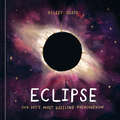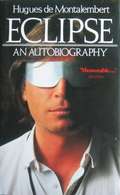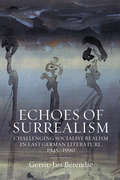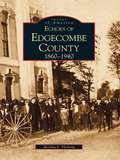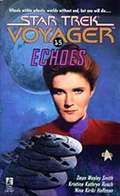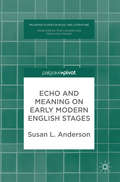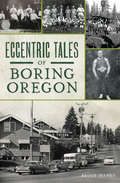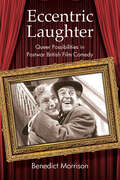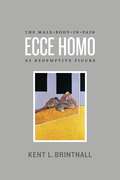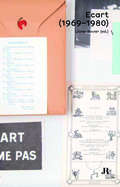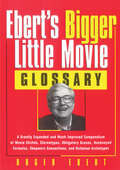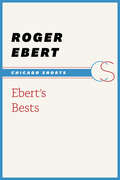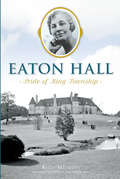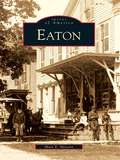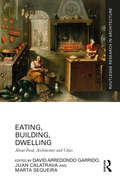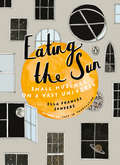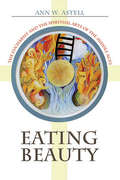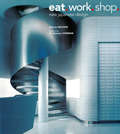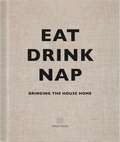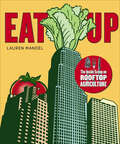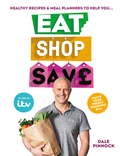- Table View
- List View
Eclipse: Our Sky's Most Dazzling Phenomenon
by Kelsey OseidDiscover the ancient myths and fascinating science of the world&’s most striking celestial phenomena—eclipses—in this educational, beautifully illustrated guide by the acclaimed author of What We See in the Stars.Awe-inspiring, majestic, and always a little otherworldly, eclipses have captivated our imaginations for thousands of years. Whether plunged into darkness as the sun disappears in the middle of the day or enchanted by the moon&’s blood red glow as a vast shadow creeps across its surface, our ancestors both feared and revered eclipses, seeking to understand these striking celestial events through both storytelling and science.In Eclipse, celebrated artist and author Kelsey Oseid explores the science and mystique of lunar and solar eclipses, from the myths of our ancestors to today. Did you know that in Chinese legends, solar eclipses were caused by dragons eating the sun? Or that the Norse people believed that a sky wolf chased away the moon? Oseid presents these rich historical stories alongside informative, accessible science to enrich your understanding: a solar eclipse only occurs during a new moon; a selenelion is when you can see the lunar eclipse in front of you and the sunset behind you; and the Mars Rovers have even taken photographs of eclipses from Mars.Filled with captivating information and vivid, colorful illustrations, Eclipse will delight and inspire astronomy lovers of all ages.
Eclipse: An Autobiography
by Hugues De Montalembert David NoakesUp until 1978, the author, a French count by birth, was a painter. He travelled extensively working on documentary films such as I A Dancer about Rudolph Nureyev and Margot Fonteyn. He took a deep interest in the culture of the countries he visited: the harlem voodoo in West Africa and Indonesian music in Bali. On May 25th 1978, when returning to his apartment in New York from a Greenwich Village coffee-house, he was met by two intruders who threw caustic solution in his face. At the age of thirty-five he was blinded for life. Hugues de Montalembert is currently based in Rome although he continues to travel between Europe, America and South East Asia. The French edition of ECLIPSE became a bestseller when it was published in 1982 and the author is currently working on his second book.
Echoes of the Civil War: Capturing Battlefields through a Pinhole Camera
by Michael FalcoA fresh and surprising look at the American Civil War through pinhole camera photographs of sesquicentennial battlefield reenactments In 2011, Michael Falco set out to document the American Civil War's 150th anniversary by photographing reenactments of more than 20 major battles--from the First Manassas, Antietam, and Chancellorsville to Gettysburg, Vicksburg, and Appomattox. But rather than shooting these historic re-creations in high-definition, Falco opted for a different, older medium: a pinhole camera. This antebellum photographic technology, shot from an on-the-ground perspective, captures these battlefields in a way that feels more "real" and fully realized than even the famous daguerrotypes made during the war itself. In Falco's transporting photographs, the smoke-filled battle reenactments become blurred and dreamlike, echoing the sentiments found in the actual letters and journals of soldiers who fought and died there. Throughout, historical photographs from the period offer context to the modern-day re-creations, showing just how much--or how little--has changed on this hallowed ground. One hundred and fifty years after the last soldier fell, Echoes of the Civil War provides beautiful and compelling evidence of a Civil War landscape that is, literally and metaphorically, still with us.
Echoes of Surrealism: Challenging Socialist Realism in East German Literature, 1945–1990
by Gerrit-Jan BerendseFor many artists and intellectuals in East Germany, daily life had an undeniably surreal aspect, from the numbing repetition of Communist Party jargon to the fear and paranoia engendered by the Stasi. Echoes of Surrealism surveys the ways in which a sense of the surreal infused literature and art across the lifespan of the GDR, focusing on individual authors, visual artists, directors, musicians, and other figures who have employed surrealist techniques in their work. It provides a new framework for understanding East German culture, exploring aesthetic practices that offered an alternative to rigid government policies and questioned and confronted the status quo.
Echoes of Surrealism: Challenging Socialist Realism in East German Literature, 1945–1990
by Gerrit-Jan BerendseFor many artists and intellectuals in East Germany, daily life had an undeniably surreal aspect, from the numbing repetition of Communist Party jargon to the fear and paranoia engendered by the Stasi. Echoes of Surrealism surveys the ways in which a sense of the surreal infused literature and art across the lifespan of the GDR, focusing on individual authors, visual artists, directors, musicians, and other figures who have employed surrealist techniques in their work. It provides a new framework for understanding East German culture, exploring aesthetic practices that offered an alternative to rigid government policies and questioned and confronted the status quo.
Echoes of Edgecombe County: 1860-1940
by Monika S. FlemingEdgecombe County, North Carolina, has a long andintriguing history stretching back to the 1730s, when the first permanent European residents began settling the banks of the Tar River, and beyond, when Tuscaroras roamed the woodlands of this fertile region. Edgecombe County was recognized as a county in 1741; just over a century later it led the nation in cotton production and was well known as a forward-thinking and prosperous county of exceptional natural beauty. The tremendous changes ushered in by the Civil War and Reconstruction coincided with the development of photography. Photographers like S.R. Alley in Tarboro, who captured life in Edgecombe County on film in the crucial era covered here, were unknowingly recording history in a way that futuregenerations will be forever grateful for.
Echoes (Star Trek #15)
by Kristine Kathryn Rusch Dean Wesley Smith Nina HoffmanThe U.S.S. Voyager finds itself in a system where a planet might have existed, but doesn't. Where the planet should have been, millions and then billions of people are appearing from nowhere and dying in the vacuum of space. To solve the mystery and save billions of lives, Captain Janeway will have to face alternate versions of herself and the crew of Voyager -- not just one almost-mirror-image, but many. Janeway will have to find a way to work with her alternate selves, with whom she shares much but each of whom has a different agenda. At stake is the survival of Voyager and the lives of billions of innocent people.
Echo and Meaning on Early Modern English Stages
by Susan L. AndersonThis book examines the trope of echo in early modern literature and drama, exploring the musical, sonic, and verbal effects generated by forms of repetition on stage and in print. Focusing on examples where Echo herself appears as a character, this study shows how echoic techniques permeated literary, dramatic, and musical performance in the period, and puts forward echo as a model for engaging with sounds and texts from the past. Starting with sixteenth century translations of myths of Echo from Ovid and Longus, the book moves through the uses of echo in Elizabethan progress entertainments, commercial and court drama, Jacobean court masques, and prose romance. It places the work of well-known dramatists, such as Ben Jonson and John Webster, in the context of broader cultures of performance. The book will be of interest to scholars and students of early modern drama, music, and dance.
Eccentric Tales of Boring, Oregon
by Bruce HaneyThe town of Boring has seen more than its fair share of interesting events since its founding in 1903. From secretly hiring an up-and-coming boxer to fight the town bully to the time firecrackers were blamed for burning down half the town, memorable moments abound. Discover the story of the wild man who lived in the woods and the attempts of Prohibition-era moonshiners to evade the law. Uncover the true identity of the Wild West Gang and the real story of a runaway train loaded with potatoes. Join author Bruce Haney as he explores the peculiar tales of an exciting town.
Eccentric Laughter: Queer Possibilities in Postwar British Film Comedy (SUNY series, Horizons of Cinema)
by Benedict MorrisonEccentric Laughter explores new ways to watch postwar British film comedies, arguing that their representations of eccentricity offered a set of possible queer futures for a Britain that had been destabilized by years of conflict and social upheaval. Far from being the apolitical cinema described by previous critics, these comedies—including both perennial favorites from Ealing Studios and neglected films ripe for rediscovery—make a joke of and suggest alternatives to the heterocentric home and family. Referencing a wide range of theories, the book gives details of how these films' comic queernesses are not structured on fixed identities but on an open play of possibilities, depicting eccentricity, artifice, drag, ruins, and the wild in ways that can still offer inspiration for experiments in living today. Engaging with contemporary queer theories and politics, the book argues that these films continue to address questions of urgent relevance to students and other viewers in the twenty-first century. Films discussed include The Belles of St. Trinian's, Genevieve, The Lavender Hill Mob, Simon and Laura, The Stranger Left No Card, and Young Wives' Tale.
Ecce Homo: The Male-Body-in-Pain as Redemptive Figure
by Kent L. BrintnallImages of suffering male bodies permeate Western culture, from Francis Bacon’s paintings and Robert Mapplethorpe’s photographs to the battered heroes of action movies. Drawing on perspectives from a range of disciplines—including religious studies, gender and queer studies, psychoanalysis, art history, and film theory—Ecce Homo explores the complex, ambiguous meanings of the enduring figure of the male-body-in-pain.Acknowledging that representations of men confronting violence and pain can reinforce ideas of manly tenacity, Kent L. Brintnall also argues that they reveal the vulnerability of men’s bodies and open them up to eroticization. Locating the roots of our cultural fascination with male pain in the crucifixion, he analyzes the way narratives of Christ’s death and resurrection both support and subvert cultural fantasies of masculine power and privilege. Through stimulating readings of works by Georges Bataille, Kaja Silverman, and more, Brintnall delineates the redemptive power of representations of male suffering and violence.
Ecce Homo
by Kent L. BrintnallImages of suffering male bodies permeate Western culture, from Francis Bacon’s paintings and Robert Mapplethorpe’s photographs to the battered heroes of action movies. Drawing on perspectives from a range of disciplines—including religious studies, gender and queer studies, psychoanalysis, art history, and film theory—Ecce Homo explores the complex, ambiguous meanings of the enduring figure of the male-body-in-pain. Acknowledging that representations of men confronting violence and pain can reinforce ideas of manly tenacity, Kent L. Brintnall also argues that they reveal the vulnerability of men’s bodies and open them up to eroticization. Locating the roots of our cultural fascination with male pain in the crucifixion, he analyzes the way narratives of Christ’s death and resurrection both support and subvert cultural fantasies of masculine power and privilege. Through stimulating readings of works by Georges Bataille, Kaja Silverman, and more, Brintnall delineates the redemptive power of representations of male suffering and violence.
Ecart (19691980)
by Lionel Bovier Christophe Cherix"(Curating) From A to Z" offers a summary of the development of curatorial practice over the last two decades seen through the eyes of curator Jens Hoffmann. <P><P>In this publication each letter of the alphabet evokes a particular word related to the world of exhibition making: From A (as in Artist) and B (as in Biennial) to R (as in Retrospective) and W (as in White Cube). Employing a diarist style, the curator presents his personal curatorial alphabet with a similar transparency and the same idiosyncratic character revealed in many of his exhibitions. The entries are not only stimulating and intellectually rigorous, but also emotionally engaging.Jens Hoffmann (b. 1974 in San Jose, Costa Rica) is a writer, exhibition maker, and educator. He currently is Deputy Director of The Jewish Museum, New York. He has published widely in journals and museum publications and has written over 200 texts on art and exhibition making over the last 15 years. <P>His most recent books include "The Studio" (2012), as well as "Show Time: A History of Exhibitions" (2014). He is the founder and editor of "The Exhibitionist: Journal on Exhibition Making." Most recently he co-curated the 9th Shanghai Biennial (2012/13) and the 12th Istanbul Biennial (2011).
Ebert's Bigger Little Movie Glossary: A Greatly Expanded and Much Improved Compendium of Movie Clichés, Stereotypes, Obligatory Scenes, Hackneyed Formulas, ... Conventions, and Outdated Archetypes
by Roger EbertAn expanded glossary of movie clichés from the Pulitzer Prize–winning film critic. The popular film critic offers a compilation of witty and wise observations about the film lexicon, including “Fruit Cart,” a chase scene through an ethnic or foreign locale, or “The Non-Answering Pet,” referring to a dead pet in a horror movie.
Ebert's Bests (Chicago Shorts)
by Roger EbertA treasury of year-by-year ten-best lists, plus personal reminiscences by the man whose name became synonymous with the movies. In Ebert&’s Bests, the iconic Roger Ebert takes us through the journey of how he became a film critic, from his days at a student-run cinema club to his rise as a television commentator in At the Movies and Siskel & Ebert. Recounting the influence of the French New Wave; his friendships with Werner Herzog and Martin Scorsese; and travels to Sweden and Rome to visit Ingrid Bergman and Federico Fellini, Ebert never loses sight of film as a key component of our cultural identity. In considering the ethics of film criticism—why we should take all film seriously, without prejudgment or condescension—he argues that film critics ought always to engage in open-minded dialogue with a movie. All this is accompanied by decades&’ worth of annual ten-best lists, which showcase Roger Ebert&’s recommendations—while at the same time reminding us that hearts and minds, and even rankings, are bound to change.
Eaton Hall: Pride of King Township
by Steve Pellegrini Kelly MathewsIn 1901, Florence McCrea married into one of the most prosperous families in the Dominion of Canada, becoming Lady Eaton fourteen years later when her husband, John Craig Eaton, was knighted. Not long after the death of her husband, Lady Eaton retired from her home in Toronto to the seventy-two-room, Norman-style chateau she had built on their King City property. She named it Eaton Hall. The estate fueled the local economy and community, supported the Canadian World War II effort and established a firm place in the hearts and minds of the residents of King Township. Rediscover an enchanting and bygone age with the life and history of Lady Eaton and her grand Eaton Hall.
Eaton
by Mary E. MessereOnce touted as the "sparkling jewel" of Madison County because of its many scenic lakes and reservoirs built to feed the great Chenango Canal, the town and hamlet of Eaton have played an important role in the history of Madison County. From within its boundaries have come such luminaries as Emily Chubbuck Judson, early women's writer; humorist Melville Landon, better known to the world as Eli Perkins; and Samuel Chubbuck, inventor and the maker of the early telegraph equipment for Samuel Morse's telegraph. Eaton captures the history of this once-thriving community through pictures and stories of the Chenango Canal, early turnpikes, and steam engines made famous by Wood, Taber and Morse's Steam Engine Works. Many of these pictures are kept for the future in the Old Town of Eaton Museum, located in one of Eaton's oldest stone buildings.
Eating, Building, Dwelling: About Food, Architecture and Cities (Routledge Research in Architecture)
by Marta Sequeira David Arredondo Garrido Juan CalatravaThe intricate relationship between food, city and architecture, spanning from ancient civilizations to the present, serves as a focal point for interdisciplinary discourse. This book delves into a diverse set of cases throughout history in which processes related to food significantly influenced architectural or urban designs.This book delineates three spatial levels — city, home and intermediate spaces — illuminating their dynamic interplay within the construct of a continually evolving “food space." Featuring 12 contributions from Mediterranean Europe, this publication explores historical legacies and contemporary challenges. Divided into urban-territorial and architectural scales, it offers nuanced insights into urban dynamics, domestic life and gastronomic tourism. Supported by a prestigious introductory study, this research advances a comprehensive understanding of food's role in shaping urban environments.Through the chapters of this book, those interested in cultural studies of food, urban history and architecture will be able to reflect on our relationship with food and its processes, and how it affects the way we live and design our cities and their architectures.
Eating the Sun: Small Musings on a Vast Universe
by Ella Frances Sanders“Strong on science but just this side of poetry.” —Nature A beautifully illustrated exploration of the principles, laws, and wonders that rule our universe, our world, and our daily lives, from the New York Times bestselling creator of Lost in TranslationHave you ever found yourself wondering what we might have in common with stars, or why the Moon never leaves us? Thinking about the precise dancing of planets, the passing of time, or the nature of natural things? Our world is full of unshakable mystery, and although we live in a civilization more complicated than ever, there is simplicity and reassurance to be found in knowing how and why. From the New York Times bestselling creator of Lost in Translation, Eating the Sun is a delicately existential, beautifully illustrated, and welcoming exploration of the universe—one that examines and marvels at the astonishing principles, laws, and phenomena that we exist alongside, that we sit within.
Eating Beauty: The Eucharist and the Spiritual Arts of the Middle Ages
by Ann W. Astell"The enigmatic link between the natural and artistic beauty that is to be contemplated but not eaten, on the one hand, and the eucharistic beauty that is both seen (with the eyes of faith) and eaten, on the other, intrigues me and inspires this book. One cannot ask theo-aesthetic questions about the Eucharist without engaging fundamental questions about the relationship between beauty, art (broadly defined), and eating."—from Eating BeautyIn a remarkable book that is at once learned, startlingly original, and highly personal, Ann W. Astell explores the ambiguity of the phrase "eating beauty." The phrase evokes the destruction of beauty, the devouring mouth of the grave, the mouth of hell. To eat beauty is to destroy it. Yet in the case of the Eucharist the person of faith who eats the Host is transformed into beauty itself, literally incorporated into Christ. In this sense, Astell explains, the Eucharist was "productive of an entire 'way' of life, a virtuous life-form, an artwork, with Christ himself as the principal artist." The Eucharist established for the people of the Middle Ages distinctive schools of sanctity—Cistercian, Franciscan, Dominican, and Ignatian—whose members were united by the eucharistic sacrament that they received.Reading the lives of the saints not primarily as historical documents but as iconic expressions of original artworks fashioned by the eucharistic Christ, Astell puts the "faceless" Host in a dynamic relationship with these icons. With the advent of each new spirituality, the Christian idea of beauty expanded to include, first, the marred beauty of the saint and, finally, that of the church torn by division—an anti-aesthetic beauty embracing process, suffering, deformity, and disappearance, as well as the radiant lightness of the resurrected body. This astonishing work of intellectual and religious history is illustrated with telling artistic examples ranging from medieval manuscript illuminations to sculptures by Michelangelo and paintings by Salvador Dalí. Astell puts the lives of medieval saints in conversation with modern philosophers as disparate as Simone Weil and G. W. F. Hegel.
Eat. Work. Shop
by Terence Conran Marcia IwatateVibrant color photography and compelling text make this the ultimate guide to modern Japanese life. Readers the world over will marvel at this collection of 21st-century commercial sites in Japan. Seven of the country's foremost architects showcase their ideas in 34 shops, restaurants, salons, bars and spas. In collaboration with a new generation of entrepreneurs, these designers are reshaping basic concepts of how contemporary Japanese eat, work and shop. Beautifully photographed, the locations in this book reflect everything from postmodern industrialism to suggestive eroticism. A whole new language of design, propelled by the Japanese penchants for innovation, has given this generation a carte blanche to redefine Japan as the world's next cultural superpower, unhindered by the barriers of tradition.
Eat. Work. Shop
by Terence Conran Marcia IwatateEat. Work. Shop. presents a striking collection of cutting-edge commercial sites in Japan.Vibrant color photography and compelling text make this the ultimate guide to modern Japanese life. Seven of the country's foremost architects showcase their ideas in 34 shops, restaurants, salons, bars and spas. The architecture and interior designs are uniquely Japanese and will add a distinctive flair to any retail, office or retail design project. In collaboration with a new generation of entrepreneurs, these designers are reshaping basic concepts of how contemporary Japanese eat, work and shop. Beautifully illustrated with over 250 photos, the locations in this book reflect everything from postmodern industrialism to suggestive eroticism. A whole new language of design, propelled by the Japanese penchants for innovation, has given this generation a carte blanche to redefine Japan as the world's next cultural superpower, unhindered by the barriers of tradition.
Eat, Drink, Nap: Bringing the House Home
by Soho House UK LimitedThe quintessential style, cooking, and home interior book from Soho House, the world's leading members' club.Since the first Soho House opened its doors over 25 years ago, we've learnt a bit about what works. Contemporary, global yet with something quintessentially English and homely at its heart, this is Soho House style explained by its experts:- From planning a room to vintage finds: bringing the Soho House look home.- Our House curator's advice on how to buy, collect and hang art.- The art of a great night's sleep: how to design the perfect bedroom.- No-fuss recipes and chef's tips: here's how to make your favourite House dishes.- Inside Babington: our take on country-house living. Wellies optional.- Flip-flop glamour and poolside style from Soho House Miami Beach.- All the secrets of cocktail hour: House tonics and barman's tips.- Spa treatment at home, DIY facials and chocolate brownies.Eat Drink Nap, a 300-page highly illustrated book, with a foreword from founder Nick Jones, and photography from leading food and interiors photographers Mark Seelen and Jean Cazals, shares the Soho House blueprint for stylish, modern living, the Soho House way.___________________________________________Readers love EAT, DRINK, NAP:'A fun and stylish guide to a better life''A perfect coffee table book!''I love it and people comment and do flick though it when they are at my home''Simple but elegant. . . and chocked full of beautiful pictures and wonderful information for making your house a home.'
Eat Up: The Inside Scoop on Rooftop Agriculture
by Lauren MandelFrom roof to table – urban food has reached new heights.Soaring prices and concerns about chemical-laden fruits and vegetables increasingly drive us to grow our own healthy food close to home. In cities, however, vanishing ground space and contaminated soils spur farmers, activists, and restaurateurs to look to the skyline for a solution. The hunger for local food has reached new heights, and rooftops can provide the space that cities need to bring fresh, organic produce to tables across North America.The first full-length book to focus entirely on rooftop agriculture, Eat Up views this growing movement through a practitioner's lens, explaining:Structural, access, and infrastructural considerationsZoning and building codesProven growing techniquesBusiness and marketing strategiesThis graphically rich guide provides inspiration and advice to aspiring growers through photographs of successful rooftop farms and gardens and interviews with industry professionals. Easy-to-use checklists and a decision tree are included to help gauge the viability of each unique rooftop opportunity. Essential reading for home gardeners, entrepreneurs, restaurateurs, policy makers, academics, and designers, Eat Up takes urban agriculture to a whole new level, proving that rooftop farming is not just pie in the sky—it is the future of urban food.Lauren Mandel holds a master's degree in landscape architecture from the University of Pennsylvania and a bachelor of arts degree in environmental science. She is a project manager and rooftop agriculture specialist at Roofmeadow, where she designs green roofs and oversees green roof and rooftop agriculture projects around the country.
Eat Shop Save: Recipes & mealplanners to help you EAT healthier, SHOP smarter and SAVE serious money at the same time
by Dale Pinnock**THE SUNDAY TIMES BESTSELLER**Television tie-in Eat Shop Save contains over 80 recipes to restore sanity to the challenges of family cooking!Focusing on the time-poor in particular, these delicious meals will put a smile on the fussiest of eaters and entice families with chapters such as: Quick After Work Suppers, Favourites with a Facelift and Something Sweet (but good for you).Food is just the beginning. Using smart shopping and meal planning as a basis, you'll find tips to get organised, save money and free up precious time. - Weekly meal planners in each chapter help you save money- Make your own quicker, healthier 'takeaways'- Hide vegetables for fussy eaters- Become a smart shopper- Upcycle leftover ingredients - Give classic dishes a facelift
